Tom's Hardware Verdict
Complete with colorful case options and enthusiast features, the NovelKeys NK87 - Entry Edition is a great choice for TKL fans new to the custom mechanical keyboard hobby. Long-term durability is a concern, and you’ll need to re-lube the stabilizers, but treated with care, it’s a good value for the money.
Pros
- +
+ Well priced for the features and potential of the product
- +
+ Uncommon color choices for added personalization
- +
+ South-facing switches and screw-in stabilizers (included) for wide compatibility
- +
+ Hot-swappable switches
- +
+ Easy to open up and mod
Cons
- -
Long-term durability may be a concern
- -
Poor stock lubing on stabilizers
- -
Included cable is unimpressive
Why you can trust Tom's Hardware
If there’s one thing the NovelKeys team knows how to do, it’s play to the crowd. Following up on 2020’s popular NK65 - Entry Edition, the NK87 - Entry Edition is the latest barebones keyboard kit from a team that lives and breathes mechanical keyboards. Its storefront sells everything enthusiasts and newcomers alike would need: switches, keycaps, lube, accessories and, of course, keyboard kits to install all of those goodies into. NovelKeys keeps one ear to the ground and is close to the community it serves.
Nowhere is that more true than in the NK87 - Entry Edition. The NK65 was considered one of the best options for newcomers to the hobby at the time of its release, but a lot has happened since then and the kit has begun to show its age. The NK87, on the other hand, is built around modern sensibilities. Gasket mounting? It’s got an answer for that: thock absorbers. Case and PCB damping? It’s got muffle mats. Flexible typing experience? Removable mounting posts.
The keyboard still has areas for growth, but this year’s Entry Edition is a solid and effective evolution of what the NK65 did right. At only $135, including screw-in stabilizers and a great travel case, it’s a great option if you’ve been curious about the custom keyboard hobby but aren’t ready to jump to a compact layout like the Zoom65’s.
In addition to the NK87 - Entry Edition, NovelKeys sent over the Aluminum Edition ($285) for comparison and review, as well as a handful of keycaps sets to try on each. This review will focus primarily on the Entry Edition, but we’ll be showcasing and comparing against the Aluminum Edition throughout so you can decide which NK87 is the best fit for you.
Specifications
| Switches | None included |
| Lighting | Per key RGB |
| Onboard Storage | 4 - 16 layers |
| Media Keys | Secondary layer |
| Connectivity | USB Type C to Type A |
| Cable | Coiled, rubberized |
| Additional Ports | None |
| Keycaps | None included |
| Software | VIA or QMK |
| Dimensions (LxWxH) | 14.3 x 5.3 x 0.7 inches |
| Weight | 2.98 pounds |
Design of the NovelKeys NK87 - Entry Edition
At first blush, the NK87 seems like a pretty standard TKL mechanical keyboard. Its top-down design is a simple rectangle with uniform bezels around the keyset. As is often the case in the keyboard hobby, it’s when you look more closely that the differences really begin to pop out.
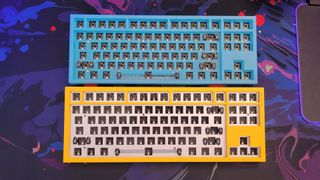
Pop is an apt word here because, depending on your color choice, the NK87 can go from minimalist and unassuming to downright eye-catching. The Entry Edition is made from injection-molded polycarbonate plastic and comes in everything from basic black, white, and beige to atomic purple and the neon blue, or “blumen,” we were sent. The NK87 - Aluminum Edition takes it a step farther with celestially-inspired solar yellow, nebula pink, and comet blue color options.
The brightest of these colors, blumen/comet blue, nebula pink, and solar yellow are uncommon, even in the custom keyboard world. Be prepared to field questions and comments if you choose any of these colors. More importantly, think about the keycaps you’d use before pulling the trigger. Finding matching keycaps for Solar Yellow is especially tricky, especially considering that both boards use a larger, 7u Spacebar.
As barebones keyboard kits, the two NK87 kits follow the trend of not including switches and keycaps. It’s an extra cost to consider, but a standard practice among keyboard kits. It comes assembled apart from these two elements, so all you’ll need to do is press the switches into the hot-swap sockets and add keycaps before being ready to type.
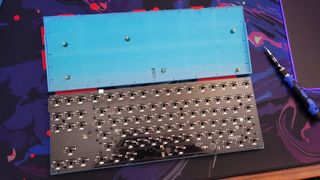
NovelKeys has definitely learned a thing or two since the original NK65 - Entry Edition. This time around, it comes with a set of NovelKeys’ own screw-in stabilizers instead of plate mounts, pre-lubed with what looks like Krytox. If you’d rather swap out to a set of Durock V2s — pretty much an industry standard among keyboard enthusiasts — you’ll need to open the case and unscrew the stock stabs, but it’s not difficult to access and accomplish.
The case is much easier to get into and doesn’t require any tools if you have fingernails. Instead of using fasteners, the top shell simply snaps into place using plastic tabs. Long-term durability may be a concern, but in opening and closing the case a half dozen times for this review, it didn’t show any worrying signs whatsoever. The founder of NovelKeys commented on Reddit that he had opened his own 40-50 times without issue, but obviously, your mileage may vary.



Inside the case, the keyboard has four main components. The plate (also polycarbonate), PCB, a thick layer of silicone in the bottom half of the case to dampen typing sounds, and a thinner sheet of molded silicone between the plate and PCB to do the same. NovelKeys calls these Muffle Mats. There are also removable silicone tabs Novelkeys calls thock absorbers along the inner rim of the top case to further isolate typing sounds.

The NK87 - Entry Edition is a tray mount keyboard, so the PCB assembly screws into the bottom case. One of its more interesting qualities is that it can be modified to become much closer to a gasket mount by removing the metal standoffs from the bottom of the case and simply letting it rest between the silicone and thock absorbers. It doesn’t meet the flexy expectation of a gasket mount thanks to the gaskets being firm rubber instead of soft foam but accomplishes a similar goal in isolating keystrokes and delivering a bit of softness to typing.
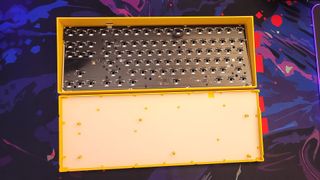
While much of this is true of the NK87 - Aluminum Edition, there are some key differences. First off, it’s top mount (the PCB screws into the top case) and there are multiple screws that have to be removed to access its internals. The silicone pad on the bottom half of the case is much thinner and doesn’t work as well, and since it’s top mount, there’s no way to modify the typing experience like on the Entry Edition. It’s also much firmer to type on. Despite sharing a name, the experience of using both keyboards is quite different.
Both keyboards have more in common than they do different, however. They both feature per-key RGB. They both use QMK/VIA for programming and remapping keys. They both include excellent traveling cases. They both also have mediocre coiled USB cables with rubberized exteriors, a bit like an old-school telephone cord. Both keyboards offer a complete package, but the Entry Edition feels like a much better value for the money, especially when the typing experience is factored in.
Assembling the NovelKeys NK87 - Entry Edition
Assembling the NK87 - Entry Edition is very simple. Assuming you don’t want to perform any modifications, you can simply press the switches and keycaps into place and be ready to go. You can expect a decent, but not great, typing experience by going that route, so I suggest taking a few minutes to at least lube the stabilizers.

Disassembling either version of the NK87 involves a few steps, but the Entry Edition is the easier of the two. The top case is held on by a series of retention clips and snaps on and off. I had to use a spudger the first time I tried removing it, but after that, simply grabbing the edge with a fingernail was enough to lift it up and off. Take care not to force anything — it is plastic after all — but disassembly is faster and easier than with most other keyboards
The NK87 - Aluminum Edition uses fasteners. Lots of fasteners. There are six screws holding the two halves of the case together. With the case separated, another twelve screws hold the plate to the top case. If you want to separate the plate and the PCB, there are two more screws to remove (the Entry Edition also has this). It’s not bad, per se, but is definitely a stark contrast to its cheaper cousin, the NK87 - Entry Edition.
Once either case is open, you can remove the plate or case silicone simply by lifting it off the guideposts. The silicone tabs on the top case also slot into guides rather than use adhesive, so adding or removing any of these elements is easy.

The Entry Edition has the unique ability to remove the standoffs that mount the plate and PCB to the bottom base. NovelKeys recommends using a small socket to remove these to prevent cracking the case, but if you prefer a slightly softer typing experience, it’s an easy modification that only takes a couple of minutes to apply.
Typing Experience on the NovelKeys NK87 - Entry Edition
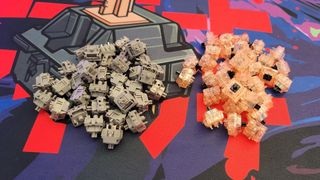
Because the NK87 doesn’t come with switches, the typing experience will vary depending on what you choose and which keycaps you install. For my test, I used NovelKeys’ NK_ Silk switches (Olivia Edition) on the Entry Edition and NK_ Cream Tactile switches on the Aluminum Edition. The difference between both was night and day, but gave a good impression of the different experiences you would be likely to have depending on your preferences.








For keycaps, NovelKeys sent over a selection of its own in-stock sets: sand, stone, taro, and Heisenberg (officially licensed Breaking Bad keycaps). I settled on Heisenberg for the Entry Edition (and eventually combined it with a normal white-on-black set I had on hand) and stone for the Aluminum Edition. Each of the sets is very well done and high-quality. They’re made of thick PBT and use dye-sublimated legends so they’ll never fade or shine over time. They’re also complete enough to outfit a wide array of keyboards, including those with split or oddly-sized spacebars.
Even though I love heavy-duty aluminum mechanical keyboards, the Entry Edition much better matched both my sound preference and what seems to be popular in mechanical keyboards today. The silicone pads did a great job of getting rid of any sense of hollowness in the case whatsoever. The same is true of the thock absorbers. You’re hearing a dampened but very pleasant version of the switch you’re using, free of any sharpness or reverberation.

The Aluminum Edition was very different. The muffle mat in the bottom case is so much thinner that it feels like it shouldn’t even share a name. There was more reverberation and the spring noise coming from the stock NK_ Cream Tactile switches did ring quietly through the case. The mats and thock absorbers aren’t ineffective (the noise is worse without), but they don’t go far enough to actually remove these effects.
But you may not want to. While the Entry Edition is much more subdued and slightly poppy, the Aluminum Edition is louder and doesn’t mute the character of the switches as much. It’s definitely worth taking the time to lube your switches to minimize the amount of ping that will carry, but I actually found it to be pretty satisfying to type on.
The Entry Edition is easily the softer of the two keyboards to type on. The metal plate and top mount assembly of the Aluminum Edition kill any flex out of the gate. Some users prefer a firmer typing experience and they’ll get that in spades here. The Entry Edition itself isn’t very flexy, but the polycarbonate plate and silicone pads dampen keystrokes enough that it’s noticeably softer to type on.
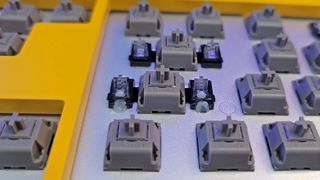
One area that you’re definitely going to want to revisit, and NovelKeys will hopefully address in future batches, is the stabilizers. They come pre-lubed…or so it appears. Every stabilizer on my samples had big globs of lubricant where the wire enters the stabilizer housing. Some were actually a bit messy and spilled out onto the plate. Unfortunately, that excess lube never made its way into the stabilizer where most of the rattle comes from. The rattle wasn’t as bad as on your average gaming keyboard, but you’ll definitely want to go through and re-lube these properly.
Both of my units also had issues with the Spacebar ticking. I was able to get rid of this on the Aluminum by adding more lube, but it kept coming back on the Entry Edition no matter how much I added. It turns out that it was due to a slight bend in the stabilizer wire that needed to be straightened.

Let’s be real here: I’m a keyboard geek and have trained myself to listen for these things. If you’re not deep into the world of mechanical keyboards, you probably won’t even notice. The problem is, if you do take the time to lube the other stabilizers, you’re actively listening for issues like this. They matter. Clearly, there’s room for improvement in QC for the stabilizers.
Ticking spacebar aside, I found both keyboards very easy to type on. The front height of 0.7 inches made using each board comfortable without a wrist rest. The standard layout and sizing also made transitioning to the keyboards completely seamless. My average typing speed hovers between 100-110 words per minute and across five tests on MonkeyType, I averaged 108 WPM on these boards.
Gaming Experience on the NovelKeys NK87 - Entry Edition
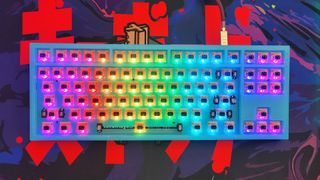
Neither of the keyboards are designed for gaming, but as we’ve seen with other custom keyboards, they’ll work perfectly well for it with a few conditions. The biggest thing to know is that there are no gaming-specific features on either board. They’re simple TKLs, without macro buttons or RGB effects that flash in rhythm with your game. Both do offer N-Key rollover, but that’s a standard feature at this point and doesn’t lend it much of an edge in most games anyway.
That said, I was able to play everything from Call of Duty: Vanguard to World of Warcraft without any problem at all. Responsiveness wasn’t an issue at my level, and I couldn’t tell a difference even when tested side-by-side with my Corsair K95 RGB Platinum XT. NovelKeys didsn’t disclose the polling rates for these boards, however, so it’s hard to say whether they’re running at 1000 Hz like a normal gaming keyboard.
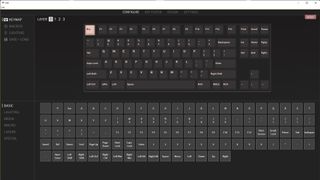
Working to both NK87s’ benefit is QMK and VIA programmability. Using VIA, you’re able to program in up to four layers of keymaps. Since the TKL form factor delivers most of the standard keys right on the top layer with physical buttons, that essentially means the other three layers are free to be mapped to custom commands or layouts. In World of Warcraft, for example, I dedicated one of those layers to movement with my left hand and all of my skills on the right.
Just don’t go in expecting iCUE levels of customization here. The biggest gaming keyboard brands have invested heavily in their software suites to deliver advanced features like syncopated RGB lighting, timers, Windows shortcuts, and mouse control all within a few clicks. VIA and QMK are open-source and, while you can do the basics like recording a text string macro, anything beyond that is too cumbersome to do on the fly.
Software for the NovelKeys NK87 - Entry Edition
Like many of the other custom keyboards we’ve reviewed, QMK and VIA support come standard. As I described in the previous section, QMK is an open-source toolset that allows coders to re-write the firmware of their keyboards to enable advanced features like multi-function keys.


For those of us who don’t want to code, QMK Configurator and VIA sweep in to save the day with easy-to-understand graphical interfaces. VIA takes it a step further by making these changes apply instantaneously while QMK Configurator requires flashing the firmware to the board with a separate program. VIA also makes it easy to record and apply simple macros, while the Configurator doesn’t offer that functionality at all. Instead, it ups programmability to 16 layers instead of four. It’s a trade-off, but the ease of making changes with VIA has led to a wide embrace of the program within the enthusiast community.
With either GUI option, remapping keys is extremely simple. You simply click the key you would like to change and click the key you would like there instead. This includes advanced options like media and RGB controls, as well as basic Windows shortcuts like My Computer or launching the calculator.

You can also record macros on the Macro tab, but it doesn’t take long before the limitations become apparent. A simple text string is as simple as typing in what you would like and clicking Save. Anything more complex, like a string with key combinations, requires typing in the actual keycodes as pictured above. For gaming, it just doesn’t make sense unless it’s a macro you’ll be using often and which won’t require changes.
QMK is a popular choice because of how free it is. Inside VIA, I regularly remap my Caps Lock key to access my second layer when held and send Caps when tapped. From there, I map arrows to IJKL and key functions like Home, End, Page Up, Page Down, Print Screen and Delete around it. Using this functionality, I never need to move my hands from the Home Row, making the NK87 (and every other QMK keyboard I own) uniquely my own.
One thing you won’t find is the ability to remap individual LED colors like you can in competing gaming software like Razer Synapse. Instead, you can customize lighting across the entire keyboard, adjusting the speed of animated effect, brightness, hue, and saturation. I’ve found this to be enough for me, but if you like to program custom layouts, the NK87 and any QMK keyboard is going to leave you wanting.
Bottom Line


The NK87 - Entry Edition and NK87 - Aluminum Edition are compelling keyboards in their own right, but while value is in the eye of the beholder, there seems to be a clear winner here. Despite costing $150 less, the Entry Edition feels like a much more compelling option thanks to its improved acoustics, streamlined assembly, and customizable typing feel. With both keyboards at my disposal, it was the Entry Edition I found myself reaching for the most.
The Aluminum Edition is hardly a bad keyboard. If you prefer a firmer typing experience and crave the premium feeling of a heavy aluminum case, it delivers. It’s also worth calling out the wide range of bright colors NovelKeys offers it in: the Aluminum Edition has personality! Its thinner silicone pad isn’t quite thick enough to ward off a bit of hollowness and reverberation, however.
Neither is the best for gaming exclusively. For that, I would recommend a dedicated gaming keyboard like the Corsair K70 TKL or the Razer Huntsman V2 TKL. If you’re not a big gamer but are looking for a full aluminum TKL, the Drop CTRL High Profile is a good option at only $150 for the barebones kit, freeing up those extra funds to invest in keycaps and switches.
They share a name, but these two keyboards target different audiences and it shows. The Entry Edition leans more into modern sensibilities and offers an overall better experience out of the box. There’s still room for improvement in the QC department, but this is a solid option for newcomers to the hobby, especially if you’re willing to take the time to re-lube the stabilizers.

Chris is a regular contributor for Tom’s Hardware, covering mechanical keyboards, peripherals, and content creation gear.
-
bkuhl Did I miss something? Why do you do keyboard reviews without include a sound test when that is one of the most important things people are interested in?Reply
